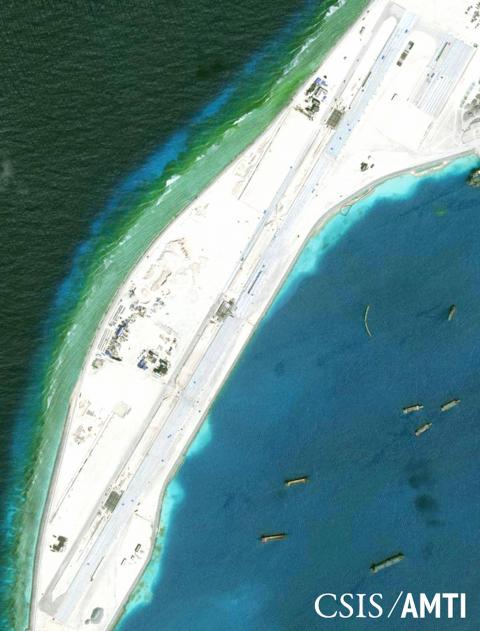The US Navy plans to conduct another passage near disputed islands in the South China Sea early this month, a source familiar with the plan said on Friday, the third in a series of challenges that have drawn sharp rebukes from China.
The exact timing of the exercise and which vessels would travel inside a 12 nautical mile (22.2km) limit around a disputed island was not immediately clear.
The US has conducted what it calls “freedom of navigation” exercises in recent months, sailing near disputed islands to underscore its right to navigate the seas.

Photo:Reuters
US Navy officials have said they plan to conduct more and increasingly complex exercises in the future.
The USS Stennis carrier strike group is operating in the South China Sea.
The next freedom of navigation exercise is unlikely to be conducted by a carrier like the Stennis, but rather by a smaller ship, the source said.
Experts predict the next US challenge to territorial claims by China in the South China Sea could occur near Mischief Reef (Meiji Reef, 美濟礁), part of the Spratly Islands (Nansha Islands, 南沙群島), which Taiwan also claims.
Mischief Reef was submerged at high tide before China began a dredging project to turn it into an island in 2014.
Mischief Reef is now the site of one of three military-length airfields China has built on artificial islands in the Spratly archipelago.
US Navy ships regularly patrol the South China Sea, through which more than US$5 trillion of world trade travels every year. China claims most of the area, while Taiwan, Vietnam, Malaysia, Brunei and the Philippines have rival claims.
In recent months, with tensions rising around China’s reclamation activities, US ships have been frequently and routinely shadowed by Chinese ships and regular communications with Chinese vessels have often been tense.
News of the planned exercise came a day after US President Barack Obama met with Chinese President Xi Jinping (習近平) at a nuclear summit in Washington.
During the meetings, Xi told Obama that China would not accept any behavior in the disguise of freedom of navigation that violates its sovereignty, sending a clear warning to the US.
Chinese Ministry of Foreign Affairs spokesman Hong Lei (洪磊) on Saturday told reporters that China opposed any such exercise.
“China consistently respects and supports the freedom of navigation and flyover that all countries enjoy in the South China Sea under international law, but resolutely opposes any country using so-called freedom of navigation as an excuse to damage China’s sovereignty, security and maritime rights,” Hong said.

The US government has signed defense cooperation agreements with Japan and the Philippines to boost the deterrence capabilities of countries in the first island chain, a report by the National Security Bureau (NSB) showed. The main countries on the first island chain include the two nations and Taiwan. The bureau is to present the report at a meeting of the legislature’s Foreign Affairs and National Defense Committee tomorrow. The US military has deployed Typhon missile systems to Japan’s Yamaguchi Prefecture and Zambales province in the Philippines during their joint military exercises. It has also installed NMESIS anti-ship systems in Japan’s Okinawa

‘WIN-WIN’: The Philippines, and central and eastern European countries are important potential drone cooperation partners, Minister of Foreign Affairs Lin Chia-lung said Minister of Foreign Affairs Lin Chia-lung (林佳龍) in an interview published yesterday confirmed that there are joint ventures between Taiwan and Poland in the drone industry. Lin made the remark in an exclusive interview with the Chinese-language Liberty Times (the Taipei Times’ sister paper). The government-backed Taiwan Excellence Drone International Business Opportunities Alliance and the Polish Chamber of Unmanned Systems on Wednesday last week signed a memorandum of understanding in Poland to develop a “non-China” supply chain for drones and work together on key technologies. Asked if Taiwan prioritized Poland among central and eastern European countries in drone collaboration, Lin

Renewed border fighting between Thailand and Cambodia showed no signs of abating yesterday, leaving hundreds of thousands of displaced people in both countries living in strained conditions as more flooded into temporary shelters. Reporters on the Thai side of the border heard sounds of outgoing, indirect fire yesterday. About 400,000 people have been evacuated from affected areas in Thailand and about 700 schools closed while fighting was ongoing in four border provinces, said Thai Rear Admiral Surasant Kongsiri, a spokesman for the military. Cambodia evacuated more than 127,000 villagers and closed hundreds of schools, the Thai Ministry of Defense said. Thailand’s military announced that

CABINET APPROVAL: People seeking assisted reproduction must be assessed to determine whether they would be adequate parents, the planned changes say Proposed amendments to the Assisted Reproduction Act (人工生殖法) advanced yesterday by the Executive Yuan would grant married lesbian couples and single women access to legal assisted reproductive services. The proposed revisions are “based on the fundamental principle of respecting women’s reproductive autonomy,” Cabinet spokesperson Michelle Lee (李慧芝) quoted Vice Premier Cheng Li-chiun (鄭麗君), who presided over a Cabinet meeting earlier yesterday, as saying at the briefing. The draft amendment would be submitted to the legislature for review. The Ministry of Health and Welfare, which proposed the amendments, said that experts on children’s rights, gender equality, law and medicine attended cross-disciplinary meetings, adding that